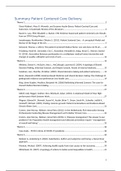Summary Patient Centered Care Delivery
Theme 1..............................................................................................................................................3
Cheryl Rathert, Mary D. Wyrwich, and Suzanne Austin Boren: Patient-Centred Care and
Outcomes: A Systematic Review of the Literature.........................................................................3
Naomi L. Lacy, PhD; Elisabeth, L. Backer, MD: Evidence-based and patient-centered care: Results
from an STFM Group Project..........................................................................................................6
Jayadevappa, Ravishankar; Chhatre S. (2011). Patient Centered Care – A conceptual Model and
Review of the Stage of the Art........................................................................................................7
Schwenk, Thomas L. (2014). The patient-Centered Medical Home: one size does not fit all.......11
Friedberg, Mark W., Schneider, Eric C., Rosenthal, Meredith B, Volpp, Kevin G., Werner, Rachel
M. (2014). Association Between participation in a multiplayer medical home intervention and
changes in quality, utilization and costs of care............................................................................12
Theme 2............................................................................................................................................13
Whitney, Simon N., McGuire, Amy L., McCullough, Laurence B. (2004). A typology of Shared
Decision Making, Informed Consent, and Simple Consent. Annals of internal medicine..............13
Sandman, Lars, Munthe, Christian. (2009). Shared decision-making and patient autonomy.......15
Barat, Alexandra (2008). Evidence Based Medicine and shared decision making: the challenge of
getting both evidence and preferences into health care..............................................................19
King, Jaime Staples, Moulton, Benjamin W. (2006) Rethinking informed Consent: The case for
shared Medical Decision-Making..................................................................................................22
Theme 3............................................................................................................................................27
Gittell, Jody Hogger, Seidner, Ron, Wimbush, Julian. (2010). A relational Model of How High-
performance Work Systems Work................................................................................................27
Wagner, Edward H., Bennett, Susan M., Austin, Brian T., Green, Sarah M., Schaefer, Judith K.,
Vonkorff, Michael. (2005). Finding common ground: Patient-Centeredness and Evidence-Based
Chronic Illness Care......................................................................................................................31
Cramm, Jane Murray, Nieboer, Anna Petra (2012). In the Netherlands, Rich Interaction Among
Professionals Conducting Disease Management Led To Better Chronic Care...............................34
Cramm, Jane Murray, Nieboer, Anna Petra (2016). Is ‘diasease management’ the answer to our
problems? No! Population health management and (disease) prevention require ‘’management
of overall well-being’’...................................................................................................................35
Theme 4............................................................................................................................................36
Case study – PCCD in times of COVID-19 pandemic.....................................................................36
Theme 5............................................................................................................................................36
Nieboer A, Lindenberg S. (2002). Substitution, buffers and subjective well-being: a hierarchical
approach.......................................................................................................................................36
Marmot, Michael. (2007). Achieving health equity from root causes to fair outcomes...............39
Whitehead, M. (2007). A typology of actions to tackle social inequalities in health....................41
1
, Seeleman, Conny, Suurmond, Jeanine, Stronks, Karien. (2009). Cultural competence: a
conceptual framework for teaching and learning.........................................................................43
Nieboer, Anna P., Cramm, Jane M. (2018). How do older people achieve well-being? Validation
of the social production function instrument for the level of well-being.....................................45
Steverink, Nardi, Lindenberg, Siegwart, Slaets, Joris P. J. (2005). How to understand and improve
older people’s self-management of well-being............................................................................47
Theme 6............................................................................................................................................50
Barr, Victoria, et al. (2003). The expanded Chronic Care Model: An integration of concepts and
strategies from population health promotion and the chronic care model..................................50
Menec, Verena, H. Means, Robin, et al. (2011). Conceptualizing Age-friendly communities.......56
Epping-Jordan, J.E. et al. (2004). Improving the quality of health care for chronic conditions.....60
Nieboer, Anne P., Jane M. (2017). Age-Friendly communities Matter for Older People’s well-
being.............................................................................................................................................63
Cramm, Jane M., Nieboer, Anne P. (2018). Aging perceptions matter for the well-being of elderly
Turkish migrants, especially among the chronically ill..................................................................64
2
, Theme 1
Cheryl Rathert, Mary D. Wyrwich, and Suzanne Austin Boren: Patient-
Centred Care and Outcomes: A Systematic Review of the Literature
Abstract: this study focuses on the relationship between PCC and the clinical outcomes. The study
researched 3 databases of 40 articles and found a strong evidence for positive influences of PCC on
satisfaction and self-management.
The objective of this review is to examine the PCC literature with attention to how PCC has
been operationalized, and how it has been empirically associated with outcomes.
The article looks at the 8 dimensions of PCC and how to integrate these setting so PCC can serve as a
foundation for improving care (see lecture 1 for the dimensions). Before this study there has been 2
other studies who looked at the relationship between PCC and the clinical outcomes, however this
study also looks at the moderating and mediating variables
Identifying moderators will lead to greater understanding of how certain contexts or patient
life circumstances may influence PCC and patients, hence, will explain some variability in
outcomes unrelated to processes.
Conceptual Framework
This article looks at the framework of Donabedian’s (1988) structure-process-outcome, he said the
following: “good structure increases the likelihood of good process, and good process increases the
likelihood of good outcome’’
According to this framework there are 2 elements of process:
- A technical process
Which include appropriate diagnoses and strategies for care based on knowledge, judgment,
and skill in implementing the strategies
- An interpersonal process
Which include exchange of information necessary for an accurate diagnosis, and to
determine preferences and acceptability for specific care methods.
Technical care is implemented through interpersonal interactions; therefore, the success of
technical care depends on interpersonal processes
The article came with the following conceptual framework with moderators and mediators:
3





